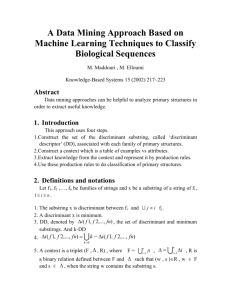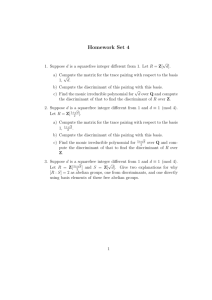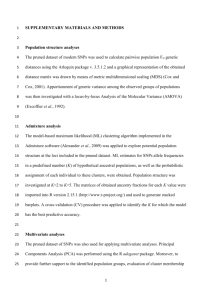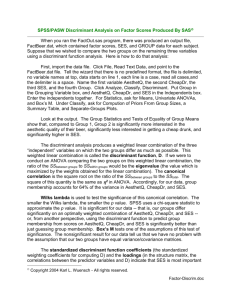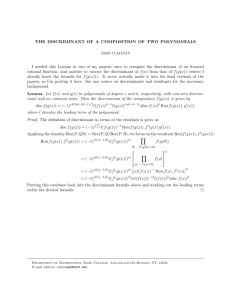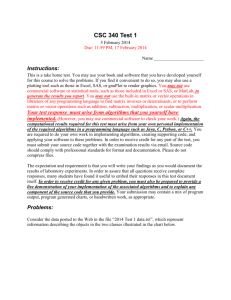Stock Return and Fundamental Variables: A Discriminant Analysis
advertisement
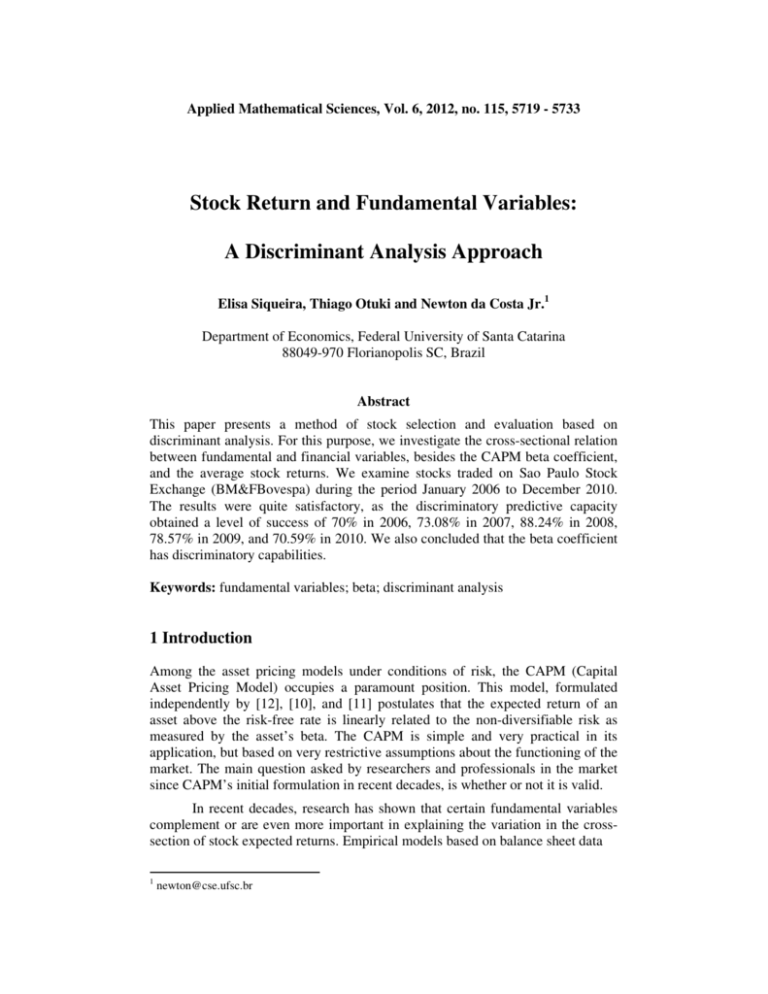
Applied Mathematical Sciences, Vol. 6, 2012, no. 115, 5719 - 5733 Stock Return and Fundamental Variables: A Discriminant Analysis Approach Elisa Siqueira, Thiago Otuki and Newton da Costa Jr.1 Department of Economics, Federal University of Santa Catarina 88049-970 Florianopolis SC, Brazil Abstract This paper presents a method of stock selection and evaluation based on discriminant analysis. For this purpose, we investigate the cross-sectional relation between fundamental and financial variables, besides the CAPM beta coefficient, and the average stock returns. We examine stocks traded on Sao Paulo Stock Exchange (BM&FBovespa) during the period January 2006 to December 2010. The results were quite satisfactory, as the discriminatory predictive capacity obtained a level of success of 70% in 2006, 73.08% in 2007, 88.24% in 2008, 78.57% in 2009, and 70.59% in 2010. We also concluded that the beta coefficient has discriminatory capabilities. Keywords: fundamental variables; beta; discriminant analysis 1 Introduction Among the asset pricing models under conditions of risk, the CAPM (Capital Asset Pricing Model) occupies a paramount position. This model, formulated independently by [12], [10], and [11] postulates that the expected return of an asset above the risk-free rate is linearly related to the non-diversifiable risk as measured by the asset’s beta. The CAPM is simple and very practical in its application, but based on very restrictive assumptions about the functioning of the market. The main question asked by researchers and professionals in the market since CAPM’s initial formulation in recent decades, is whether or not it is valid. In recent decades, research has shown that certain fundamental variables complement or are even more important in explaining the variation in the crosssection of stock expected returns. Empirical models based on balance sheet data 1 newton@cse.ufsc.br 5720 E. Siqueira, T. Otuki and N. da Costa Jr. and firm characteristics, although there is no theory to justify this fact in advance, bring interesting results and serve as support in the decision-making of investors. We can cite [5] as a main reference, as well as [4] and [2]. The aim of this paper is to propose an ad-doc method, based on discriminant analysis, to help investors and analysts in their decisions on stock selection. In section 2 we present the method of discriminant analysis in the context of multivariate analysis; section 3 refers to the methodology, testing and data used in this work; section 4 analyzes the results; and finally, we conclude the paper in section 5. 2 Discriminant Analysis The multivariate analysis started with the contributions of [6], [8], [13] and [3]. Initially, these techniques were used in the field of botany. Currently, these techniques are used in various fields of knowledge. In the economic-financial area, discriminant analysis has been applied widely in studies of bankruptcy prediction of firms such as [1]. In the stock market, we can cite the study of [9] that compares various forecasting techniques including discriminant analysis. Discriminant analysis is a multivariate analysis technique that relates a categorical dependent variable with metric independent variables (or categorical). The linear combination of discriminant analysis, also known as the discriminant function is determined by an equation which takes the following form: ⋯ where is the discriminant Z score for object k, is the intercept and are a set of coefficients (weights) for the independent variables . Discrimination takes place through the establishment of the weights for each independent variable in such a way that maximizes the distinctions between the groups. The statistical discriminant variable, called discriminant function, serves to separate, as best as possible, the entities between the two groups (A and B) as shown in Figure 1. Stock return and fundamental variables 5721 Figure 1: Distribution (Discriminant Function) To determine the groups, or the definition of the cutoff point, one must perform the centroid calculation of each group. The centroid is the arithmetic mean of the discriminant scores of each group used to find the cutoff point that will distinguish the variables in each group. The cutoff point is also called Z critical, which depending on the sizes of the groups, may be defined in accordance with Hair et al. (2009), as: 1) Cutoff score for two groups of equal size = /2 2) Cutoff score for different size groups = / For this technique to be used, certain conditions must be observed, such as: multivariate normality of independent variables, homogeneity of variance and covariance matrices, absence of multicollinearity and linearity. 3 Methods To obtain the best discrimination possible, we used the stepwise method in SPSS package. This method is characterized as a procedure in which the independent variables are being successively included in the model, testing, with every inclusion, if that variable contributes to the improvement the discriminating power of the model. In the end, the set of variables that best discriminate the groups of the discriminant function predominates. There are a number of parameters to estimate the discriminant function through stepwise. The parameter used here was the Mahalanobis D2 which represents the Euclidean distance between the centroid of a group and an 5722 E. Siqueira, T. Otuki and N. da Costa Jr. observation of this same group. The variables that showed the greatest distance are included in the model. The statistical distance between two points , … , and , … , in which the p-dimensional space is defined as: !" , # $ % & $ and !" , 0 ‖‖) % & is the standard of . The variables with the greatest capacity to contribute to the maximization of the distinction of the characteristics of each group are identified. The difference between the group means for each independent variable was ascertained, using Wilk's Lambda test. 1 || 1 Λ |,| 1 /0 02 where the determinant || is the measure of variability within groups, and |,| is the measure of the total variability. In this test, the smaller the calculated value of the statistic, the greater the difference between the groups’ means for each variable and therefore the greater the discrimination power of the variable, as a level of significance. The Box's M test checks the equality of the variance and covariance matrices, and if they are homogeneous, the discriminant analysis ultimately provides more meaningful results. The eigenvalue is a measure of the difference between the groups in the discriminant function. The canonical correlation determines how much, in percentage, the function explains the discrimination between the groups. For this, one should increase the canonical correlation to its squared value. The goal of canonical correlation is to determine a linear combination for each group of variables (dependent and independent) that maximizes the correlation between the two groups. To express the canonical correlation, one determines the linear combination of X and Y: 3 4 4 … 45 5 6 7 7 … 78 8 so that the correlation 9:;; 3, 6 is maximized. We used Kolmogorov-Smirnov’s adherence to the normal curve test to verify the normality of each variable. It is still necessary to observe whether there is multicollinearity among the independent variables, i.e., whether or not they are highly correlated. As suggested by Hair et al. (2009), one should seek to identify sets of regressors that have correlations above 0.7 - in module - to avoid multicollinearity. Stock return and fundamental variables 5723 3.1 Data The population of our study comprised of all stocks traded in the Sao Paulo Stock Exchange (BM&FBovespa) during the period January 2006 to December 2010, and available in the Economatica database. After collecting these data, it was found that some companies did not have all the variables needed to perform the analysis, whether that be for not having traded during the period established or for having been closed or incorporated. Because of this, these companies were removed from the final sample. Thus, for each year we have a different number of stocks in the sample. In 2006, we had 96 stocks and in the subsequent years, we had 128, 170, 175 and 173 stocks, respectively. 3.1.1 Dependent variable After filtering the populations by the criteria established above, two portfolios were formed for each year (each containing 20% of the total population) sorted in descending order based on their returns. Thus, to form two portfolios with the stocks of each year, we highlighted the most profitable 20% (top quintile) and 20% less profitable (lowest quintile). The variables were dealt with based on economic-financial and market data from companies belonging to the final sample, having been divided between dependent and independent variables. In the present study, the dependent variable was divided into "Higher returns" and "Lower Returns". For this, the stock closing prices for the first and last day of each year were collected, and the stock return was estimated by: => $ 1A ∗ 100, where 0 is the stock’s closing price. 0 <= >?@ Companies whose returns were in the top quintile (20% most profitable) were coded with the number 1 (Highest Returns). And those companies whose returns were in the lowest quintile (20% least profitable) were coded with the number 2 (Lowest Returns) as shown in Table 1A, in the Appendix. 3.1.2 Independent variables The independent variables of the model were comprised of fundamental and financial variables, in addition to the beta coefficient, and are classic variables used in the capital market as a method of stock valuation. Special attention was given to the variable "market value", which actually is not an index, but a gross value, and therefore is represented in rather high monetary terms. Thus, to standardize it according to the other variables and make the analysis more meaningful its logarithm was calculated. The following are the variables used in the model: 5724 E. Siqueira, T. Otuki and N. da Costa Jr. a) Fundamental variables: Price-to-Earnings Ratio Price-to-Book Ratio Dividend Yield Market Value b) Financial variables: Earnings per Share (EPS) Return on Equity (ROE) Net Profit Margin Debt Ratio Current Ratio Overall Liquidity Ratio Quick Ratio c) Beta Coefficient The beta coefficient was estimated by C DE;>, ;F G H ;F , where 9I 0 , J is the covariance between the asset returns and the market portfolio returns, and K J is the variance of market portfolio returns. 3.1.3 Cross Validation Finally, in order to verify the accuracy of the models (ability to discriminate between the two groups) on the classification of the shares, they will be compared to their original classification (groups 1 and 2), or "Return Greater than or Less than" with the position of each one according to the value of its discriminant score. 4 Results After the definition of the sample, the next step necessary for the application of discriminant analysis was the selection of relevant and significant variables that would nourish the model. To this end, using the statistical package we verified the validity and representativeness of the explanatory variables. The next step was the completion of the steps required to identify the discriminant function and its application to groups of pre-defined stocks. A priori, we calculated the Kolmogorov-Smirnov test to verify the normality of each variable. The results of this test for the period studied are shown in Table 1. Looking at data from 2006 and 2007, we find that only four of the twelve variables did not follow the normal level of 10%, while for the years 2008 and 2009 this amount dropped to two out of twelve variables, making this result even better than others. For the year 2010, in turn, the same result as 2006 and 2007 with only four of the twelve variables not following the normal level of 10% can be observed. 5725 Stock return and fundamental variables Table 1: Kolmogorov-Smirnov Test (p-values) Variable Price-to-Earnings Ratio Price-to-Book Ratio Dividend Yield Log(Market Value) Earnings per share Return on Equity Net Profit Margin Debt Ratio Current Ratio Overall Liquidity Ratio Quick Ratio Beta 2006 2007 2008 2009 2010 0.00* 0.04* 0.03* 0.59 0.01* 0.24 0.80 0.10* 0.01* 0.05* 0.04* 0.57 0.00* 0.04* 0.05* 0.91 0.00* 0.49 0.00* 0.18 0.05* 0.00* 0.10* 0.94 0.00* 0.00* 0.06* 0.21 0.01* 0.00* 0.00* 0.01* 0.01* 0.00* 0.00* 0.22 0.00* 0.00* 0.00* 0.98 0.05* 0.00* 0.00* 0.00* 0.00* 0.00* 0.00* 0.55 0.00* 0.00* 0.00* 0.96 0.00* 0.00* 0.00* 0.00* 0.23 0.09* 0.20 0.51 * Statistically significant. Still according to Hair et al. (2009), one of the a characteristics of the discriminant analysis is its robustness in that even if the variables that are not distributed normally are present, the analysis results are still valid since the success of the model depends more on its ability to separate the groups correctly. After performing the test for checking the normality of the variables, one moves to the step of application of the discriminant analysis itself. To obtain the best discrimination possible, we used the stepwise method. The independent variables are measured based on the Mahalanobis D2 distance, with the variable that presents the greatest distance, i.e., the greatest Mahalanobis D2 value, being included in the model. The following variables were identified as having a greater capacity to contribute to the maximization of distinguishing the characteristics of each group. In this sense, the difference between the group means for each independent variable was identified as being significant or not, by using the Wilk’s Lambda test. The results for the respective years are shown in Table 2. From the analysis of the table, it appears that both for the year 2006 as for 2007, eleven of the twelve variables have no significant statistical difference at 10%, therefore, have no significant statistical discriminating power. For the year 2008 this result was four to twelve, representing that only four variables were not significant at 10%. Again in 2009 the result went up, where seven out of twelve variables were not significant at the level established. Finally, the year 2010 had six variables that were not significant, or in other words, half of the total variables. 5726 E. Siqueira, T. Otuki and N. da Costa Jr. Table 2: Wilk´s Lambda Test (Test for Equality of Means) 2006 2007 2008 2009 2010 Wilk´s λ p-value Wilk´s λ p-value Wilk´s λ p-value Wilk´s λ p-value Wilk´s λ p-value Variable Price-to-Earnings Ratio Price-to-Book Ratio Dividend Yield Log(Market Value) Earnings per share Return on Equity Net Profit Margin Debt Ratio Current Ratio Overall Liquidity Ratio Quick Ratio Beta 0.974 0.959 0.998 0.989 0.999 0.949 0.986 0.945 0.986 0.963 0.995 0.882 0.323 0.213 0.808 0.524 0.839 0.162 0.469 0.145 0.47 0.235 0.666 0.00* 0.982 0.968 0.953 0.849 0.976 1.000 0.991 0.987 1.000 0.99 0.978 0.961 0.342 0.202 0.123 0.00* 0.277 0.9 0.508 0.425 0.907 0.48 0.294 0.162 0.994 0.993 0.779 0.79 0.842 0.971 0.948 0.999 0.846 0.939 0.924 0.486 0.535 0.496 0.00* 0.00* 0.00* 0.164 0.06* 0.771 0.00* 0.04* 0.02* 0.00* 0.976 0.993 0.937 0.999 0.955 0.996 0.998 0.986 0.986 0.985 0.986 0.855 0.09* 0.497 0.03* 0.784 0.07* 0.614 0.749 0.03* 0.324 0.321 0.322 0.00* 0.988 0.965 0.962 0.984 0.991 0.956 0.985 0.985 0.981 0.981 0.963 0.927 0.03* 0.10* 0.10* 0.307 0.447 0.08* 0.321 0.327 0.258 0.261 0.09* 0.02* * Statistically significant. Another important test is Box’s M test, which checks the equality of variance and covariance matrices, and if they are homogenous, the discriminant analysis ultimately provides more meaningful results. According to Table 3, the pvalue for each year in 2006/2010 is less than the level of significance 5%, rejecting the homogenous matrices hypothesis. Table 3: Box´s M Test (Test for Equality of the Covariance Matrices) Variables 2007 2008 2009 2010 Box' M 4.9 6.23 F statistic 4.78 6.11 P-value 0.03* 0.01* * Statistically significant. 2006 14.71 4.74 0.00* 247.69 39.3 0.00* 74.18 6.93 0.00* Table 4 indicates the value of the eigenvalue, which is a measure of the difference between the groups in the discriminant function. In this case there is only one function, and the variance of the difference between the groups is 100%. The canonical correlation, which also appears in the table, determines how much in percentage the function explains the discrimination between groups. According Hair et al. (2009), to achieve this one should increase the canonical correlation to its squared value. Thus, one has to stop and look at the year 2006 when 0.34422 = 0.12, i.e., the function explained 12% of the discrimination between the groups. For the years 2007, 2008, 2009 and 2010 the percentages are 16%, 58%, 28% and 23% respectively. 5727 Stock return and fundamental variables Table 4: Eigenvalues and Canonical Correlations Ano 2006 2007 2008 2009 2010 Eigenvalue Variance (%) Canonical Correlation 0.134 0.178 1 398 0.388 0.303 100 100 100 100 100 0.344 0.398 0.764 0.529 0.482 4.1 Defining the functional determinant Having structured the variables and verified their statistical properties, the next step is to estimate the function which aims to calculate the score of each group of stocks. The coefficients of the non-standardized discriminant function should be used to make the estimate. From these coefficients one can find the discriminant function, to which the variables’ gross values will later be applied in order to find the scores which will then help determine the appropriate classifications. The discriminant function found for the years of the study period can be viewed below2: 2006: L $M. OPQ R. STPUR 2007: L $T. RVR M. VPRUR 2008: L $R. STW $ M. RWRUR R. OOTUW 2009: L M. QXR M. MRQUR M. MMRUW $ R. RPQUS 2010: L M. MSR M. MTWUR M. RWWUW $ M. XPPUS R. QPXUQ Then, to test the significance of the function we have the Wilk’s Lambda test for discriminating function (see Table 5). It is observed that the p-values for every year are statistically significant, indicating that the population means of the two groups are different. Table 5: Wilk´s Lambda Test (Discriminant Function Significance Test) Year 2006 2007 2008 2009 2010 Wilk´s λ 0.88 0.85 0.42 0.72 0.77 * Statistically significant. Chi-Squared P-value 4.72 8.11 56.86 21.82 16.94 0.03* 0.00* 0.00* 0.00* 0.00* 2006 ( = Beta); 2007 ( = Market value); 2008 ( = Dividend Yield, = Beta); 2009 ( = Price to earnings, = Financial Debt, Y = Beta) and 2010 ( = Price/Net Asset Value, = Dividend Yield, Y = Quick Ratio, Z = Beta). 2 5728 E. Siqueira, T. Otuki and N. da Costa Jr. It should also be observed whether there is multicollinearity among the independent variables, i.e., whether or not they are highly correlated. It is shown here that only the variables that best discriminate the groups were selected as the model, and one can perceive that none of the variables are highly correlated (see Table 6), i.e. their values are not closely correlated to one another. Table 6: Multicollinearity between variables (2008, 2009 and 2010) Dividend Yield Beta Multicollinearity between variables (2008) Dividend Yield Beta 1 0.05 0.05 1 Price-to-Earnings Ratio Debt Ratio Beta Multicollinearity between variables (2009) Price-to-Earnings Ratio Debt Ratio 1 0.14 0.149 1 0.164 0.46 Price-to-Book Ratio Dividend Yield Quick Ratio Beta Beta 0.16 0.46 1 Multicollinearity between variables (2010) Price-to-Book Ratio Dividend Yield Quick Ratio 1 0.01 -0.09 0.01 1 0.11 -0.09 0.11 1 0.25 -0.19 0.03 Beta 0.25 -0.19 0.03 1 4.1.2 Analysis of discriminant weights To assess the importance of each variable to the discriminant function, one must observe the standardized coefficients of the function. The standardized coefficients are the product of the non-standardized coefficients by the roots of covariance. In Table 7 (see non-standardized coefficients in Table 8), ignoring the sign, we find that the coefficients that contribute most to discrimination between the groups are, in descending order, the beta, the price to earnings, return on assets, and finally, the current ratio. The results indicate that beta, despite the restrictions of the CAPM, is still the factor that has the most weight in explaining stock returns. Beta was only excluded from the function in 2007 by the stepwise method. However, the results suggest that investors take into account other additional factors besides the risk, to price the expected return on the Brazilian market. P/E and P/NAV had significant weights in the years 2009 and 2010. 5729 Stock return and fundamental variables Table 7: Coefficients of the Standardized Discriminant Function Year 2006 2007 2008 2009 2010 Variables Beta Log (Market Value) Dividend Yield Beta Beta Price-to-Earnings Ratio Debt Ratio Price-to-Book Ratio Dividend Yield Quick Ratio Beta Coefficient 1 1 -0.495 0.894 -1.097 0.511 0.759 -0.604 -0.505 0.58 0.795 Table 8: Coefficients of the Non-Standardized Discriminant Function Year 2006 2007 2008 2009 2010 Variables Coefficient Beta Intercept Log (Market Value) Intercept Dividend Yield Beta Intercept Price-to-Earnings Ratio Debt Ratio Beta Intercept Price-to-Book Ratio Dividend Yield Quick Ratio Beta Intercept 1.387 -0.974 0.571 -8.151 -0.121 1.998 -1.382 0.014 0.001 -1.174 0.461 0.082 0.122 -0.677 1.476 0.031 4.1.3 Calculating the centroids After finding the discriminant function, one must perform the centroid calculation of each group. The centroid is the arithmetic mean of the discriminant scores of each group used to find the “cutoff point” that will distinguish the variables in each group. The values of the centroids are found in Table 9. 5730 E. Siqueira, T. Otuki and N. da Costa Jr. Table 9: Groups Centroids Year 2006 2007 2008 2009 2010 Group Mean Value of the Function 1 2 1 2 1 2 1 2 1 2 0.358 -0.357 -0.415 0.412 -1.165 1.165 -0.584 0.790 0.102 0.679 Once the values of the centroids have been found, one must determine the Zcritical cutoff point, which is the value that separates the groups of stocks with returns in the top quintile (group 1) from those with profitability in the bottom quintile (group 2). Thus, a stock is classified as belonging to the group of higher returns if the calculation result of its discriminant score is below the cutoff point. On the other hand, a stock is classified as belonging to the group of lower returns if the calculation result of its discriminant score is above the cutoff point. 4.1.4 Calculating the determinant score for each stock After defining the function, one must perform the calculation of the discriminant score for each stock by inserting the variable values for each one into the estimated discriminant function. This calculation is performed by the SPSS software, which also ranks stocks from among the existing groups (with profitability in the top quintile and profitability in the bottom quintile). Then using the classification of SPSS, compare the results with the original classification of each of the stocks and find the model’s degree of accuracy in relation to its objective, which is to correctly classify the stocks in their respective groups. The percentage of correct validations serves as guidance for defining the satisfactory performance of the model as in the current description. If the percentage were raised, the violation of some assumptions (normality, equal variance-covariance matrices, among others) of the discriminant analysis would not be considered serious. Analyzing the results, it is clear that in 2006, among the 40 stocks that were included in the analysis by the software, 28 were classified correctly which represents an accuracy of 70.00%. For the other years from 2007 to 2010, these adjustments were 73.08%, 88.24%, 78.57% and 70.59% respectively. These results are considered quite satisfactory, when compared to other designs, which Stock return and fundamental variables 5731 make use of the discriminant analysis, such as the predictive models of insolvency, whose degree of accuracy varies from 70 to 90%. 5. Conclusions The purpose of this paper was to develop an ad hoc method of stock valuation, based on fundamental and financial variables and the beta coefficient, which could serve as an aid to investors and analysts regarding the process of decision making on stock selection. In order to achieve this goal, we used the statistical tools of discriminant analysis. An instance of the analysis that deserves mention is the fact that the CAPM-beta coefficient has been incorporated by the model in all years, except 2007, as a variable that has a better capacity to distinguish the stocks between the groups. In 2008, we can see from the canonical correlation that it was the year that the function best discriminated the groups of "Greater Returns" and "Lower Returns" through beta and dividend yield variables. This fact indicates that in times of crisis investors are more risk-sensitive and look for assets that distribute more dividends. In terms of the discriminatory predictive capacity, we came to the conclusion that it reached a level of success of 70% in 2006, 73.08% in 2007, 88.24% in 2008, 78.57% in 2009 and 70.59% in 2010, considered to be very satisfactory results within the literature of discriminant analysis. References [1] E. Altman, Financial ratios, discriminant analysis and the prediction of business failure, Journal of Finance, 23 (1968), 589-609. [2] W. C. Barbee, S. Mukherji and G. A. Raines, Do sales-price and debtequity explain stock returns better than book-market and firm size? Financial Analysts Journal, 52 (1996), 56-60. [3] M. S. Bartlett, Multivariate Analysis, Journal of the Royal Statistical Society, 9 (1947), 176-197. [4] K. C. Chan, Y. Hamao and J. Lakonishok, Fundamentals and stock returns in Japan, Journal of Finance, 46 (1991), 1739-1764. [5] E. F. Fama and K. French, The cross-section of expected returns, Journal of Finance, 47 (1992), 427-465. [6] R. A. Fisher, The use of multiple measurements in taxonomic problems, Annals of Human Genetics, 7 (1936), 179-188. 5732 E. Siqueira, T. Otuki and N. da Costa Jr. [7] J. F. Hair, R. E. Anderson, R. L. Tatham, W. C. Black and B. J. Bain, Multivariate Data Analysis, Prentice Hall, Upper Saddle River, 2009. [8] H. Hotelling, The economics of exhaustible resources, Journal of Political Economy, 39 (1931), 137-175. [9] M. T. Leung, H. Daouk and A. S. Chen, Forecasting stock indices: a comparison of classification and level estimation models, SSRN working paper number 200429, 1999. [10] J. Lintner, The valuation of risk assets and the selection of risky investments in stock portfolios and capital budgets, Review of Economics and Statistics, 47(1965), 13-37. [11] J. Mossin, Equilibrium in a capital asset market, Econometrica, 34 (1966), 768-783. [12] W. F. Sharpe, Capital asset prices: a theory of market equilibrium under conditions of risk, Journal of Finance, 19 (1964), 425-442. [13] S. S. Wilks, Certain generalizations in the analysis of variance, Biometrika, 24 (1932), 471-494. Received: June, 2012 Stock return and fundamental variables Appendix - Table 1A: Total Sample (2006-2010) 5733

